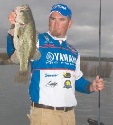 Post spawn bass have a notorious reputation for being hard to catch during the brief interval between spawning and actually starting their return to deep water, but that reputation has never bothered Yamaha pro Clark Reehm. He simply ties on a ‘wake bait’ and keeps fishing.
Post spawn bass have a notorious reputation for being hard to catch during the brief interval between spawning and actually starting their return to deep water, but that reputation has never bothered Yamaha pro Clark Reehm. He simply ties on a ‘wake bait’ and keeps fishing.
“These are crankbait-style lures with short, down-turned bills that keep them running very shallow, and the slower you retrieve them, the more they wobble with a side to side motion that’s hard for bass to resist,” says Reehm, who has used them for years in tournament competition.

“They’re effective whenever bass are shallow, but I think their best application is when fishing is tough, which happens during the post spawn. It’s a lure that attracts big bass, too. You don’t use wake baits if you’re looking for a lot of strikes, because you normally don’t get them, but the bass that do hit a wake bait are quality fish.”
Reehm really likes wake baits because he can fish them over submerged vegetation; the lure’s pronounced wobbling action literally pulls bass out of the greenery. Wake baits are also effective when fished through emerging lily pads, over shallow brush, along rocks, and even out in deep water. Because he is fishing these lures around heavy cover, he prefers either 20-lb. monofilament or even braided line; because fluorocarbon line
sinks it is not often used.
“These types of lures have long been popular on deep, clear lakes like Table Rock and Bull Shoals in Missouri,” points out the Yamaha pro, “where bass may be suspended five to 10 feet deep in timber or other cover. Even though a wake bait stays on or just below the surface, its injured minnow wobble can bring hard strikes from largemouth, smallmouth, and even striped bass.
“The key to having success with one of these lures couldn’t be easier,” Reehm continues. “All you do is reel them slowly with your rod tip high, and gradually lower your rod as the lure gets closer so you keep it right on the surface.”
Although lures of this type first appeared on the market more than 20 years ago, they all but disappeared for more than a decade as other lures and presentations became more popular. Now, however, they have become a staple for practically every tournament pro, and numerous manufacturers produce them. All have similar actions, and none are designed to dive deeper than about 18 inches.
“If you want to make one of these lures actually dive, just hold your rod tip down and reel faster,” concludes the Yamaha pro. “Sometimes I’ll do that once or twice during a retrieve just to give the bass a more erratic look, but most of the time I don’t need to.

